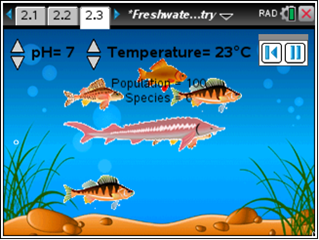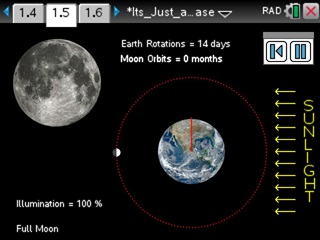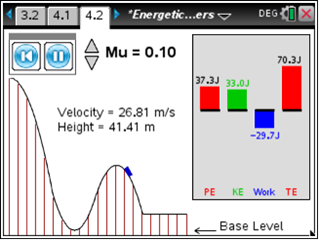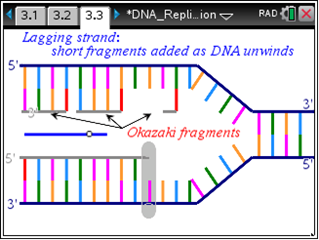Science Sims Can Be Phenomenal!
The expression “seeing is believing” is usually true. But in science education, many of the concepts can be quite difficult for students to observe because they can be very small, very large, very fast or very slow. So how can we provide students with an experience of science phenomena in the confined 45 to 90 minutes of a class period?
One option is to use simulations to give students the ability to slow down the really fast, speed up the really slow, and see the very large or very small. Simulations enable students to build a mental framework for how a “hard to see” system works. They can change variables in a simulated system to observe how each effects the system; and by doing so, students build a conceptual understanding. Simulations are tools that can be embedded within a science lesson to provide a memorable experience for students in the context of all of the background vocabulary, equations, rules, laws, or theories associated with the phenomenon.
Try these 5 simulation-based lessons with your students:
This lesson explores a hypothetical aquatic ecosystem where students can change the pH and temperature of the water. They can see a possible effect on the diversity and population size of the fish that live there.
For more information, download the Teacher Notes (pdf).
You can view and download the full TI-Nspire CX activity on our website.
2: 'It’s Just a Lunar Phase' from Earth Science
Observing moon phases takes weeks and students can usually only see them after school has ended and from Earth. This simulation allows students to see how and why the phases of the moon happen – with a view from space!
For more information, download the Teacher Notes (pdf).
You can view and download the full TI-Nspire CX activity on our website.
3: Energetic Coasters from Physical Science
Many students may not have the opportunity to visit an amusement park or may be too nervous to ride a roller coaster. They aren’t just missing out on the thrills of amusement park rides – those rides also involve a lot of awesome science! Use this simulation to help students explore the concepts of kinetic and potential energy.
For more information, download the Teacher Notes (pdf).
You can view and download the full TI-Nspire CX activity on our website.
4: 'DNA Replication' from Biology
DNA replication is one of those concepts that students simply cannot see. The process is too fast and too small to observe directly. This simulation allows them to slow down the process so they can see how DNA replication works.
For more information, download the Teacher Notes (pdf).
You can view and download the full TI-Nspire CX activity on our website.
5: 'Build an Atom' from Chemistry
Atomic structure is just about as small of a phenomenon as you can get! Explaining to students how atomic structure works will only get them so far. Having them see it by building atoms through the addition and subtraction of sub-atomic parts will help them gain a better understanding of structure and charge. This simulation is an adaptation of the very popular PhET simulations from the University of Colorado.
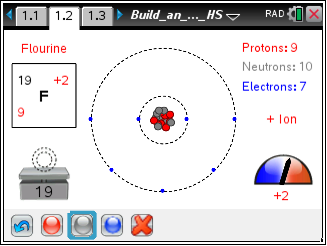
For more information, download the Teacher Notes (pdf).
You can view and download the full TI-Nspire CX activity on our website.
Tagcloud
Archive
- 2024
-
2023
- January (3)
- February (3)
- March (5)
- April (3)
- May (3)
- June (3)
- July (2)
-
August (6)
- 5 Ways to Spruce Up Your Classroom for Back to School
- Day of the Dog: Which Dog Is Roundest?
- Women Who Code: A TI Intern’s Fascinating STEM Journey
- 6 Sensational TI Resources to Jump-Start Your School Year
- 3 Back-to-School Math Activities to Reenergize Your Students
- A New School Year — A New You(Tube)!
- September (2)
- October (3)
- November (2)
- 2022
-
2021
- January (2)
- February (3)
- March (5)
-
April (7)
- Top Tips for Tackling the SAT® with the TI-84 Plus CE
- Monday Night Calculus With Steve Kokoska and Tom Dick
- Which TI Calculator for the SAT® and Why?
- Top Tips From a Math Teacher for Taking the Online AP® Exam
- How To Use the TI-84 Plus Family of Graphing Calculators To Succeed on the ACT®
- Celebrate National Robotics Week With Supervised Teardowns
- AP® Statistics: 6 Math Functions You Must Know for the TI-84 Plus
- May (1)
- June (3)
- July (2)
- August (5)
- September (2)
-
October (4)
- Transformation Graphing — the Families of Functions Modular Video Series to the Rescue!
- Top 3 Halloween-Themed Classroom Activities
- In Honor of National Chemistry Week, 5 “Organic” Ways to Incorporate TI Technology Into Chemistry Class
- 5 Spook-tacular Ways to Bring the Halloween “Spirits” Into Your Classroom
- November (4)
- December (1)
-
2020
- January (2)
- February (1)
- March (3)
- April (1)
- May (2)
- July (1)
- August (2)
- September (3)
-
October (7)
- Tips for Teachers in the time of COVID-19
- Top 10 Features of TI-84 Plus for Taking the ACT®
- TI Codes Contest Winners Revealed
- Best of Chemistry Activities for the Fall Semester
- Best of Biology Activities for the Fall Semester
- Best of Middle Grades Science Activities
- Best of Physics Activities for the Fall Semester
- November (1)
- December (2)
- 2019
-
2018
- January (1)
- February (5)
- March (4)
- April (5)
- May (4)
- June (4)
- July (4)
- August (4)
- September (5)
-
October (9)
- Art in Chemistry
- Which Texas Instruments (TI) Calculator for the ACT® and Why?
- Meet TI Teacher of the Month: Jessica Kohout
- Innovation in Biology
- Learning With Your Students
- A first-of-its-kind STEM strategy charts path to help educators
- #NCTMregionals Hartford 2018 Recap
- The Math Behind “Going Viral”
- Real-World Applications of Chemistry
-
November (8)
- Testing Tips: Using Calculators on Class Assessments
- Girls in STEM: A Personal Perspective
- 5 Teachers You Should Be Following on Instagram Right Now
- Meet TI Teacher of the Month: Katie England
- End-of-Marking Period Feedback Is a Two-Way Street
- #NCTMregionals Kansas City 2018 Recap
- Slope: It Shouldn’t Just Be a Formula
- Hit a high note exploring the math behind music
- December (5)
- 2017
- 2016
- 2015

